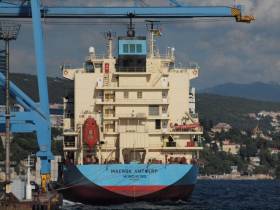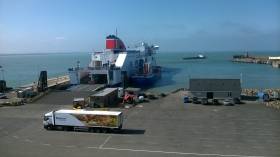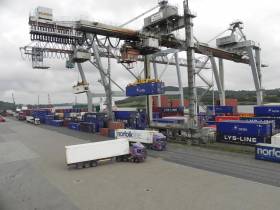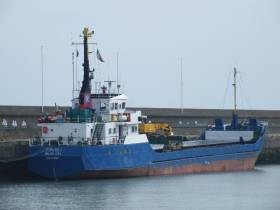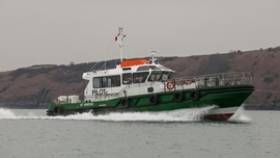Displaying items by tag: Ports and Shipping News
#WeighingContainers - All “shippers” as from July 2016 must declare to the carrier in advance the verified weight of packed containers.
The European Sea Port Organisation (ESPO) has joined the European organisations representing Shippers, Freight Forwarders and Terminal Operators in the call on national authorities to avoid any disruption in the logistics chain and to take action in coordination to preserve level playing field.
To ensure that the implementation of the new legal requirements does not create competition distortion through a patchwork of varying national measures, Member States should pursue a coordinated approach, taking into consideration the national guidelines of other Member States when deciding on national rules. Commonly accepted guidelines between supply chain actors and national authorities could minimise distortion of competition and ensure smooth functioning of the SOLAS requirements.
Being only two months away from the entry into force of the SOLAS convention, Member States should bring clarity as soon as possible.
In November 2014, the International Maritime Organisation (IMO) agreed upon rules for the mandatory weighing of all sea-bound containers to be loaded on a vessel. The undersigned organisations accept these rules and are committed to working towards the successful implementation of the new legal obligation.
#MVIrelandLaunch - M.V. Ireland, yes a vessel named after our country was launched a month ago today and is never too late mention, notably given the newbuild is one of the first dry cargoships ever to be powered by (LNG) liquefied natural gas, writes Jehan Ashmore.
The state of the art 3,600 tons cement-carrier tanker was christened at Ferus Smit's Westerbroek shipyard in the Netherlands, where a jazz band mingled among workers, guests and dignataries.
Despite her name the 110m long newbuild has no connections with the Irish maritime industry. The owners of this second sister along with M.V. Greenland already in service, are JT cement, a joint venture between Erik Thun AB and KG Jebsen Cement (KGJ) of Norway.
M.V. Ireland is registered at the Dutch port of Delfzijl on the Eems estuary and flies that nation's flag.
The liquefied natural gas (LNG) fuelled propulsion system incorporates a pressurised LNG tank positioned in the foreship. By using LNG as maritime fuel, this according to Dutch builder, is by far the most environmental-friendly solution available today.
While sailing on LNG, the vessel will meet the most stringent emission criteria, as well as new norms that might be in place in future.
The ship is equipped with a fully automated cement loading and unloading system, based on the principle of fluidization of cement with compressed air. This system enables the cement to be pumped through a completely closed, thus dust free, piping system to shore facilities.
#CaptainPhillips – Containership Antwerp which departed Dublin Port this morning, is a sister of Maersk Alabama which Somali pirates hijacked in 2009 and where the film 'Captain Phillips' is based from, writes Jehan Ashmore.
The 14,120 tonnes Maersk Alabama is the leadship and namesake of this containership class and is reputed to be the first U.S. cargoship to be hijacked in two hundred years. The pirates took over the 155m long containership under the command of Captain Richard Phillips. In the 2013 film, his character was played by actor Tom Hanks.
Only a year separates the 1998 built Maersk Alabama from the Maersk Antwerp which was renamed in recent years. The 1,058 TEU containership made the first ever direct call to Dublin Port yesterday for the Maersk Group subsidiary, Seago Line on the new UK (Liverpool)-Ireland-Spain (Algeciras) service.
The Antwerp which is one of the larger containerships to call to Dublin, departed this morning to begin in completing the first round trip of the new service. This involves the third and final leg which is bound for the southern Spanish port located west of Gibraltar.
Cargoships at Rosslare As Timber Trade Set for Further Growth
#CargoRosslare – A pair of cargoships loaded with timber in Scotland docked at Rosslare Europort, where the outlook in this trade in 2016 is for further growth at the Wexford ferryport, writes Jehan Ashmore.
Cargoship, Ayress (1979/1,713grt) loaded in Ayr on the Forth of CLyde with round timber (i.e. logs) that was discharged yesterday at Rosslare. Following that call, the Islay Trader (1992/2,386grt) loaded with cargo from Campbeltown on the Mull of Kintyre was also unloaded at the Irish port.
The timber trade began slowly in 2013/2014, but in 2015 about 20,000 tonnes of logs were imported through Rosslare using 12 shipments. Typical loading trading ports are from Scottish west coast ports, mainly Ardrishaig and Sandbank, with the occasional shipment from Campbeltown.
Both short-sea coasters berthed at Fisherman’s Quay which is the westernmost of the quays, leaving the other two piers dedicated to ferry traffic serving Wales and France. Irish Ferries operate to Pembroke, Cherbourg and Roscoff and Stena Line to Fishguard and also to Cherbourg.
The south-eastern port is also to welcome business from the cruise industry, in which Afloat will have more in an update this weekend.
Strong Growth for Irish Ports Across All Traffic Modes
#Successful2015 - According to the latest edition of the Irish Maritime Transport Economist (IMTE) the year 2015 has been successful for the maritime industry. The annual publication is issued by the Irish Maritime Development Office (IMDO).
The iShip Index, which measures the total volume of traffic moving through our national ports, recorded a 7% increase, with all major traffic modes delivering substantial growth.
Bulk traffic grew by 7% to reach 29.8 million tonnes, with Cork, Greenore, Shannon Foynes, Waterford and Wicklow recording above average growth rates.
LoLo traffic, moving predominantly through Dublin, Cork and Waterford, grew by 8% to 860,277 TEU, with each port recording significant volume gains.
RoRo traffic grew by 6% to 1,002,920 units, 88% of which was shipped through Dublin and 12% through Rosslare.
The total volume of traffic that moved through Irish ports in 2015 reached its highest level since 2008, at 977 points on the iShip Index. Although this is 7% lower than the peak of 1,042 points achieved in 2007, it represents substantial progress from the low of 693 points recorded in 2009, and is the highest level recorded since the beginning of the economic crisis.
Domestic economic conditions in 2015 contributed to the growth of the maritime industry. GDP was up by 7.8% to €203.5 billion and GNP was up by 5.7% to €171.9 billion. In value terms, exports in merchandise trade grew by 20%, while imports rose by 10%. The Central Bank of Ireland forecasts a continuation of this strong trading performance, with overall exports set to grow by a further 6.5% in 2016 and 4.9% in 2017. The Central Bank estimates that the value of imports will grow by 6.9% in 2016 and 4.4% in 2017. These strong growth rates bode well for the continued recovery and expansion of the Irish maritime industry.
Our ports are important gateways for inbound and outbound tourism and make a very significant contribution to the success of the tourism industry. More than 4.4 million passengers travelled through Dublin, Rosslare and Cork in 2015, availing of the many excellent ferry services that connect Irish ports to ports in Great Britain and France. A further 450,000 tourists experienced Ireland through port calls made by 246 cruise liners that called to Irish ports in 2015, an increase of 3% on the previous year.
Commenting on the strong performance of the industry in 2015, Liam Lacey, Director of the IMDO said “the economic contribution made by our ports to the broader economy is recognised in the Government’s integrated plan for the marine industry - Harnessing Our Ocean Wealth. The plan describes ports as enablers of economic growth. Their competitiveness and efficiency impact directly on international trade and have a direct influence on the job creation capacity of the economy.”
Director Lacey added, “As our ports move closer to the peak volumes handled in 2007/2008, it is important to address the need for additional capacity. Ambitious development plans, capable of meeting the growing needs of the national economy, have been progressed by Dublin, Cork, and Shannon Foynes and will be brought to fruition over the next five years. It is also important for other regional ports to consider the role that they will play in the provision of future capacity and in the achievement of the economic objectives set out in the Harnessing Our Ocean Wealth Strategy.”
“Apart from providing the infrastructure that is needed for shipping, our ports are important transport and logistics hubs for heavy industry requiring access to seaborne transport. A number of Irish ports have naturally occurring deep water and shore-side capacity to handle the largest ocean-going vessels and the cargoes they carry. Irish ports are also capable of providing the services and infrastructure required by the marine renewable energy industry, in which Ireland has a strategic interest.”
According to IMDO Director Lacey “The contribution that Irish ports can make to the broader marine economy by participating in these diverse activities is also recognised in the Harnessing Our Ocean Wealth Strategy and will be an important driver of growth in the maritime industry in the future”.
2015 was a good year for the Irish maritime industry and although the macro-economic and socio-political conditions that shape the performance of the global maritime industry are not without downside risks, our maritime industry is well positioned to take advantage of the forecasted growth in the Irish economy in the coming years.
First ‘Valiant’ Makes Her Launch Splash for Arklow
#Valiant – Following our pre-launch coverage of Arklow Valiant, the above footage shows the third Royal Bodewes newbuild make first contact with the water at the Dutch yard for Arklow Shipping, writes Jehan Ashmore.
Newbuilding 723 was launched from the quayside at the yard in Hoogezand, Groningen, last Friday for ASL’s Dutch division, Arklow Shipping Nederland B.V.
The single-hold 5,150dwat cargoship will became the 17th Dutch-flagged vessel out of the total fleet of 46 ships which are otherwise Irish-flagged.
Notably, she also differs to her completed 5,100dwat Trader sisters, Arklow Vale and Arklow View, in terms of an efficient and cost-effective straight stem bow design.
She is the first vessel in the Arklow fleet to be named ‘Valiant’ in the series also known as the V class. Over the decades there have been previous V class generations that have carried names among them, Valour, Venture and Villa.
The christening of Arklow Valiant will be performed at a handing over ceremony in the port of Delfzijl that is reached from the inland yard by canal. Delfzijl is where Arklow View was also named.
Unlike last year's launch of leadship Arklow Vale where the naming was carried out at the Hoogezand yard.
Port Review: Shipping Supports Duke, Belize Flagged Cargoship Detained and An Arklow First
#ShippingReview - Jehan Ashmore reviews the shipping scene over the last fortnight.
Global transportation and shipping industry leaders met in London to sign the ‘Buckingham Palace Declaration’ to fight criminal wildlife trafficking. The declaration was hailed by the Duke of Cambridge as 'a game changer in the race against extinction.'
CLdN Ro-Ro SA which operate Dublin-Zeebrugge/Dublin-Rotterdam and a network of northern Europe services, has confirmed orders for a pair of newbuilds. There are options for a further four, through Croatian shipbuilder Uljanik.
A Belize flagged cargoship Burhou I was detained in Wicklow by Port State Control due to a deficiency that kept the vessel in port for a week including St. Patrick's Day. The coaster with a port of registry of Belize City was eventually given clearence to depart and head for Belfast.
Cronus Logistics have taken over the only Ireland-Wales container service previously run by Cardiff Container Lines. The Warrenpoint-Dublin-Cardiff 'feeder' service now includes calls to Bristol.
It was all new for Arklow Shipping as the third Eco-Trader 5,100dwat cargoship, Arklow Valiant featuring a different designed was launched yesterday. The newbuild follows sisters ‘Vale’ and ‘View’ and she became the first vessel in the company’s 50th year to bear that ‘Valiant’ name.
New €3m Mobile Crane for Belview, Port of Waterford
#NewCrane - A new €3m mobile crane commissioned for Belview is a vote of confidence for the Port of Waterford.
The Port of Waterford Company welcomed the investment by Suir Shipping Ltd in the crane that loads and unload ships at Belview. This is the main terminal for the port located in Co. Kilkenny and is situated downriver of Waterford City.
The newly-commissioned Liebherr crane will be used by the stevedoring company run by the O’Brien family to service a range of ships carrying bulk cargo to and from the Southeast.
With a lifting capacity of up to 84 tonnes and the ability to discharge 1,500 tonnes per hour, the new crane is particularly well suited to the types of ship that use the facilities at Belview.
Frank Ronan, CEO, Port of Waterford, said: “We welcome this significant investment by Suir Shipping Ltd in the infrastructure they use to serve shipping customers at Belview. It is a vote of confidence by them in the future of their business which is based on efficiently servicing ships transporting bulk products to and from the region.”
New 'Saint' Pilot Boats to Keep Largest UK Energy Port Operating
#NewPilotCutters -The first of three 19m pilot boats built by Mainstay Marine Solutions, St. Brides, has been delivered to the Port of Milford Haven in south-west Wales.
The new craft was officially blessed last Thursday by Father Harri Williams of St Katherine’s and St Peter’s Church, before coming into full service.
The 48 tonne vessel is of a similar design to the ‘Picton’ pilot boat delivered to the Port in 2009. Designed by Camarc Design, these vessels have proven reliability of service over many years in the challenging sea conditions which can be found in and around the Port of Milford Haven.
Capable of reaching up to 14 knots with 12 persons on board, the crafts are designed to be used extensively in heavy weather and are likely to operate in swells up to 5m in wave height. They are able to withstand the impact of coming alongside large tankers in turbulent sea conditions and provide a safe platform when transferring pilots to and from ships visiting the various terminals along the Milford Haven Waterway. The boats are fully equipped with the latest safety and operational features and meet the highest standards of reliability and crew safety.
Alec Don, Chief Executive of the Port of Milford Haven, said: “This substantial investment of over £3.6 million in the complete renewal of our pilot boat fleet will provide the port with three identical, modern, state-of-the-art boats with full interchangeability of parts. These boats, together with our highly skilled and trained crews, constitute the backbone of our ability to provide a safe and reliable service to our customers 24 hours a day, 7 days a week. We have been impressed with the professional design and fabrication service delivered by Mainstay Marine Solutions who have delivered exactly in line with the contract”.
Stewart Graves, Managing Director of Mainstay Marine Solutions, commented: “We pride ourselves on our reputation for quality so the positive feedback on the finish of the St Brides pilot boat has been particularly pleasing. Delivering three vessels in quick succession has been a welcome challenge and we are on track to deliver the remaining two vessels to the Port of Milford Haven on time, and to budget.”
The three new vessels will replace the Port’s current fleet of four, the ‘Skomer’ and ‘Picton’ which were delivered in 2007 and 2009 respectively in readiness for the arrival of LNG, the ‘Portunus’, and the Port’s oldest vessel, the ‘Hakin’, which has been operating on the Haven since the early 1980s.
‘St Brides’ was named following a public competition which attracted almost one hundred entries. A traditional marine naming ceremony will take place for all three vessels later this year.
Dredging Completed At South Wales Port after Stormy Winter
#Dredging - A £1.5m dredging campaign at the Pembrokeshire Port of Milford Haven, to clear the shipping channels and berths has been completed.
The work is an essential part of ensuring the waters leading to and around the terminals on the river remain deep enough for some of the larger ships that use them.
Nearly 180,000 tonnes of fine silt and sand have been cleared from along berths and channels in the port over three months. The dredgers have had to work around several major storms over the period between December and March.
The work formed part of a joint campaign involving the Port of Milford Haven and a number of the other energy companies who operate terminals along the river.
“A campaign on this scale is carried out every ten years,” explained the Port of Milford Haven’s Harbourmaster, Bill Hirst. “It is vital to dredge in order to keep the UK’s biggest energy port open for business. It’s tempting to think a natural harbour such as Milford Haven is always easy to access for even the largest ships. However, the river is constantly depositing material on the seabed. We regularly need to clear out the channels so ships have plenty of room to manoeuver,” Bill continued.
The Port of Milford Haven carries out annual hydrographic surveys of the river bed to monitor build up of silt in the channels. “We have a legal duty to accurately state the depth of waters in the port,” said Bill. “With data going back several years we have a pretty clear idea how often we need to dredge to make sure those stated depths remain accurate.
Several dredging vessels were used to carry out the task. The largest was a 26,000 ton, 150m long ship the Bartolomeu Dias. In order to clear behind terminal jetties, the smaller vessel Mimar Sinan was deployed, equipped with a digging bucket capable of lifting more than 40 tonnes of material in one scoop.
The dredged material is taken to a licensed depositing ground 20 miles offshore.



























